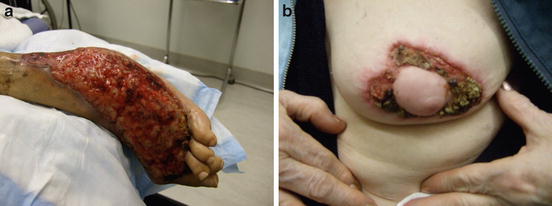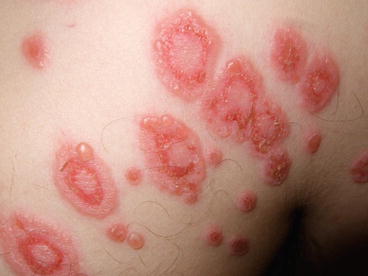Fig. 15.1
Typical presentation of erythema nodosum with tender nodules on the shins
Pyoderma gangrenosum (PG) is a rare, inflammatory disorder thought to be due to abnormal immune reactivity and/or cross-reacting autoantibodies. Clinically, it can arise over a few days on any part of the skin or mucosa. It may present in one of four distinct forms: ulcerative, bullous, pustular, or vegetative. The ulcerative form presents as a large, painful, purulent, undermined ulceration. Bullous lesions present as painful, rapidly expanding superficial bullae that erode and ulcerate. Pustular lesions present as an acute, widespread eruption of painful pustules over any part of the body. This is the most characteristic presentation of PG in patients with inflammatory bowel disease. Vegetative lesions are rare and present as hypertrophic, mildly painful nodules, or abscesses. Patients can also have systemic symptoms of fever, chills, and malaise and internal organ involvement of the liver, kidney, and spleen. This is a diagnosis of exclusion on biopsy, and frequently other conditions, such as cutaneous infections, need to be ruled out [3] (Fig. 15.2a, b).


Fig. 15.2
(a, b): Two images of different patients with severe, necrotizing, ulcerating pyoderma gangrenosum
Pyostomatitis vegetans is thought to be a variant of pyoderma gangrenosum that occurs mainly in the oral or genital mucosa. It is characterized by an acute-onset, painful, pustular or erosive eruption alongside vegetating plaques. The vesiculopustular eruption of ulcerative colitis also presents very similarly with an acute eruption of vesicles and pustules on the skin that heal with residual hyperpigmentation. Cutaneous polyarteritis nodosa is a medium vessel vasculitis that presents as painful, erythematous, purpuric, or ulcerated nodules on the lower extremities bilaterally. Metastatic Crohn’s is a non-caseating, granulomatous inflammatory disorder that appears clinically as erythematous or ulcerated nodules or plaques on the skin. Sweet’s syndrome, also known as acute febrile neutrophilic dermatosis, is characterized by fever, malaise, and an explosive eruption of dozens of erythematous, indurated, occasionally vesicular papules and plaques (Fig. 15.3). Linear IgA bullous dermatosis is an autoimmune blistering condition characterized by the eruption of multiple bullae in polycyclic or annular configurations. Epidermolysis bullosa acquisita is an acquired autoimmune disorder of type VII collagen. Patients often complain of fragile skin that blisters at sites of friction or trauma and heals with residual scar formation and milia (tiny epidermoid inclusion cysts). Psoriasis is a manifestation of inflammatory bowel-associated SpA that shares genetic features with both SpA and Crohn’s disease as defined by genetic markers at the interleukin-23 locus. Perianal skin tags, flesh-colored, well-defined, 1–10 mm, pedunculated papules, can also be found and are considered to be related to constant friction and trauma [1].










